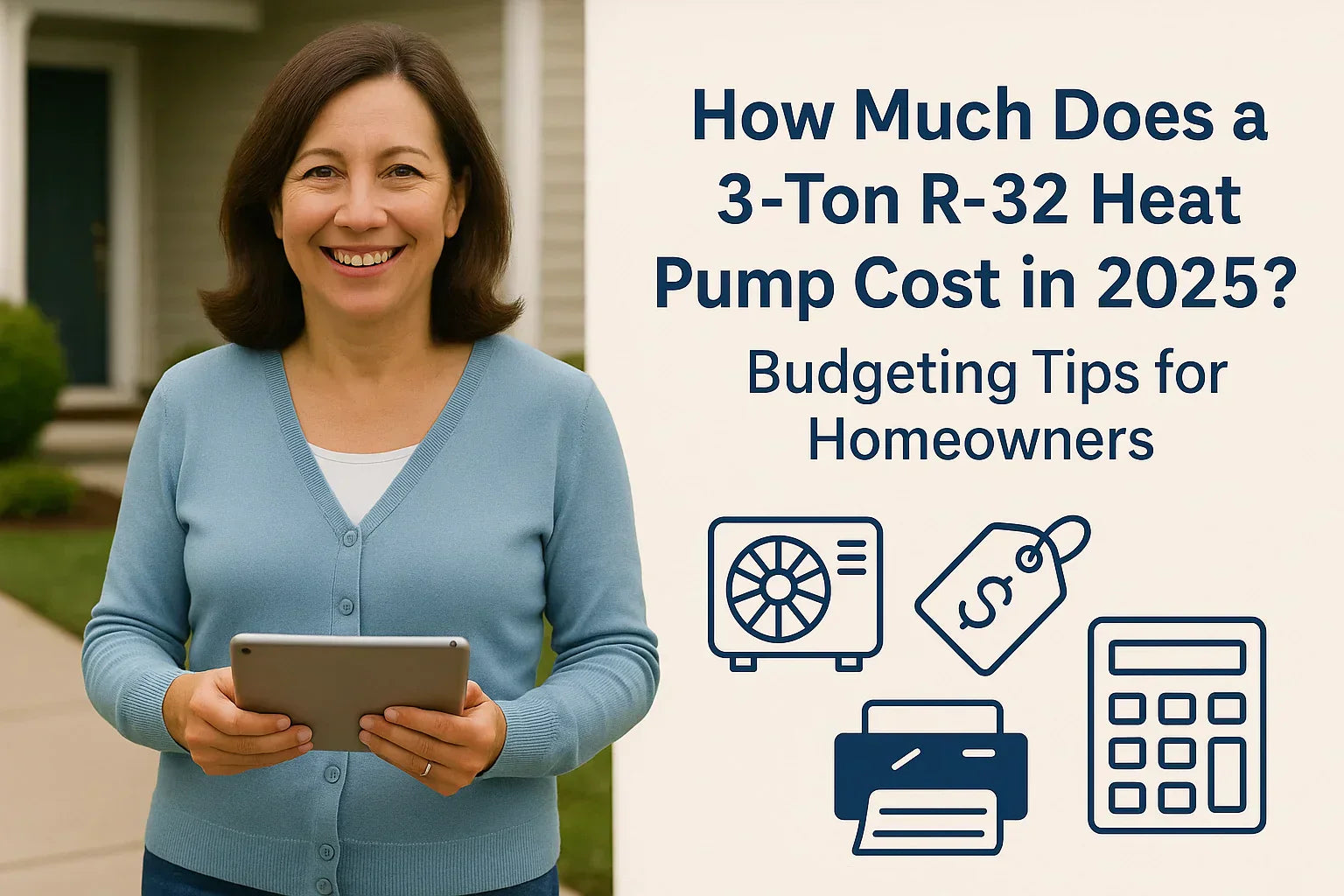💬 Introduction: Why Cost Planning Is More Than Just the Price Tag
When I started shopping for my new heat pump in early 2024, I thought I’d just need to look at the equipment price and call it a day. Oh, how wrong I was. By the time installation, ductwork tweaks, and a smart thermostat were added, my “budget-friendly” upgrade had turned into a bigger investment than I expected.
That’s why, in this guide, I’m going to break down exactly what goes into the cost of a 3-ton R-32 heat pump in 2025. I’ll share real-world numbers, explain how to avoid surprise charges, and give you practical budgeting tips to make sure you know the true price before you sign any contracts.
📦 Equipment Cost for a 3-Ton R-32 Heat Pump in 2025
Typical Price Range
In 2025, a 3-ton R-32 heat pump generally costs between $4,500 and $7,500 for the equipment alone.
The exact price depends on:
-
Brand – Premium brands like Daikin or Carrier often cost more than Goodman or Amana.
-
Efficiency rating (SEER2/HSPF) – Higher efficiency means higher upfront cost but lower energy bills.
-
Compressor type – Variable-speed and two-stage compressors tend to cost more than single-stage.
R-32 vs. R-410A Price Difference
Right now, R-32 systems are slightly more expensive in some U.S. markets simply because they’re newer. But as adoption increases, their prices are expected to level out or even undercut R-410A due to lower refrigerant charge requirements and simpler recycling (Daikin R-32 Benefits).
🛠️ Installation Labor Costs
National Averages
Professional installation for a 3-ton R-32 heat pump in 2025 typically runs $3,000 to $6,000.
What affects labor pricing:
-
Location – Labor rates are higher in urban areas with higher cost of living.
-
Installation complexity – Adding new ductwork, upgrading your breaker panel, or running long refrigerant lines adds cost.
-
Type of install – A straight swap is cheaper than converting from a furnace or adding zoning.
R-32-Specific Factors
Because R-32 is classified as A2L (mildly flammable), your installer must be certified to handle it (AHRI A2L Guidelines). This doesn’t usually increase labor rates dramatically, but you want to ensure your contractor has the right credentials.
🔧 Accessories & Add-Ons
When you upgrade your heat pump, you might also need or want:
-
Smart thermostat – $150–$400
-
Auxiliary heat strips – $300–$600
-
Surge protector – $100–$300
-
Condensate pump – $100–$250
-
Air purification/filtration upgrades – $300–$1,200
These add-ons can push your total budget up, so plan for them early.
📈 Ongoing Costs to Factor In
Even after your new system is in, you’ll want to budget for:
-
Annual maintenance – $150–$300
-
Filter replacements – $40–$120/year depending on filter type
-
Coil cleaning – Often included in maintenance, but can be $100–$200 as a standalone service
-
Occasional refrigerant service – R-32 may cost less to recharge than R-410A as phase-downs progress
💰 Total Cost Range: Real-World Examples
| System Type | Equipment | Labor | Add-Ons | Total |
|---|---|---|---|---|
| Budget single-stage | $4,500 | $3,000 | $500 | $8,000 |
| Mid-tier two-stage | $5,800 | $4,000 | $800 | $10,600 |
| Premium variable-speed, high SEER2 | $7,200 | $5,500 | $1,200 | $13,900 |
Case Study: My Neighbor’s Upgrade
Last summer, my neighbor upgraded from an old R-410A unit to a Daikin 3-ton R-32 variable-speed model. Her breakdown looked like this:
-
Equipment: $6,900
-
Labor: $4,200 (included minor duct modifications)
-
Smart thermostat + surge protector: $500
-
Total: $11,600
She’s already seeing about 18% lower summer cooling costs compared to her old system.
🏦 Financing, Rebates & Incentives
Federal Incentives
Thanks to the Inflation Reduction Act, qualifying heat pumps can get up to $2,000 in federal tax credits.
State & Utility Programs
Many states and local utilities offer $500–$3,000 rebates for high-efficiency systems, especially if they use low-GWP refrigerants like R-32.
Financing Options
-
0% promotional financing from HVAC dealers
-
Home improvement loans (APR varies)
-
Utility on-bill financing in some areas
🧮 Budgeting Tips from Samantha
Here’s what I learned the hard way:
-
Get at least 3 quotes and compare line items—don’t just look at the bottom line.
-
Ask about seasonal discounts—installing in spring or fall may save you money.
-
Check if your installer offers a service plan—it can lock in lower maintenance costs.
-
Think in 10-year terms—higher efficiency often pays for itself in utility savings.
✅ Final Checklist Before You Buy
-
Run a Manual J load calculation—don’t size by guesswork.
-
Compare warranties—parts and labor.
-
Confirm your installer is R-32 certified.
-
Factor in rebates and tax credits before finalizing your budget.
💬 Samantha’s Closing Thoughts
A 3-ton R-32 heat pump is an investment, but it’s one that pays you back in comfort, efficiency, and future readiness. By planning your budget ahead of time—and understanding every cost—you can make the leap with confidence and avoid those “surprise” expenses I ran into.
When in doubt, ask questions, demand clarity, and remember: the cheapest option isn’t always the best deal in the long run.
External Links Used
In the next topic we will read about: Single-Stage vs. Two-Stage 3-Ton R-32 Heat Pumps: Which Should You Choose?







